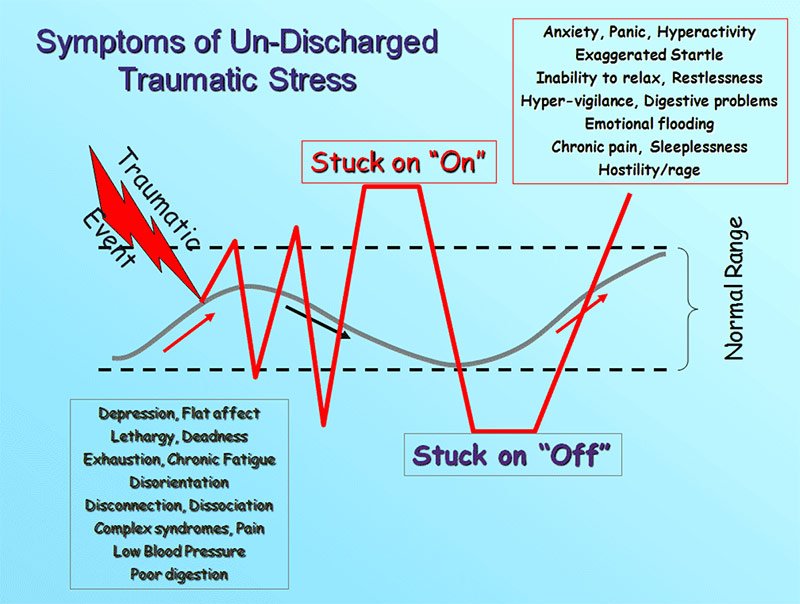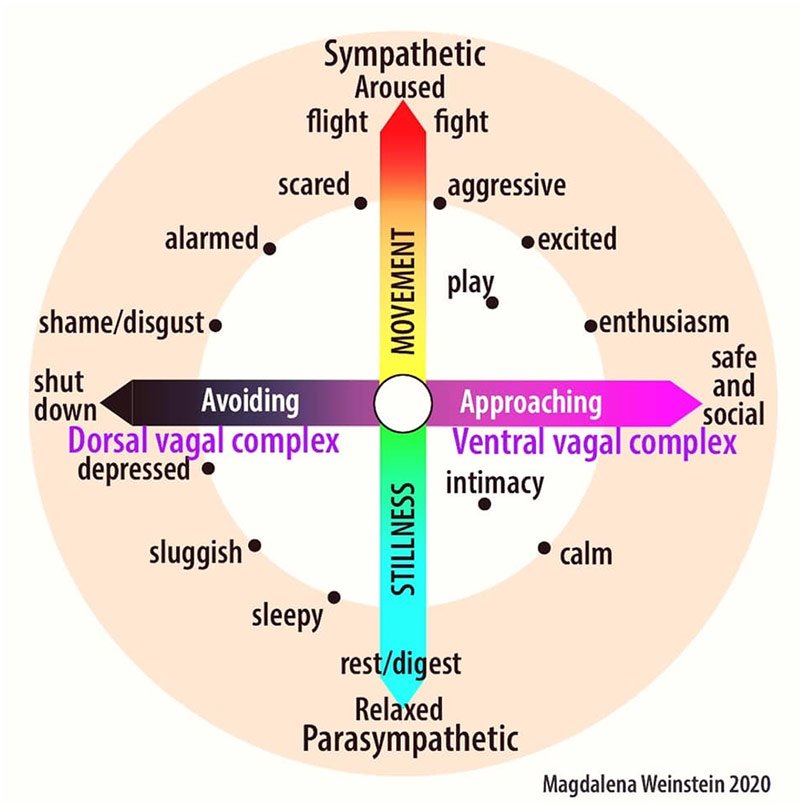
Somatic Experiencing Framework
“Trauma does not rest in the event but in the individual’s nervous system”
– Peter Levine
Somatic Experiencing is a method of processing trauma that focuses on the physical body.
It is a pioneering body-focused approach to repairing trauma.
A fearful event activates the ‘fight or flight’ response in the nervous system. This is a normal response designed to keep us alive that is time limited. Within a resilient nervous system the body’s response to the threat should return to its normal steady state range. This is called homeostasis and is referred to as the window of tolerance.
Trauma is when your body does not return to homeostasis and your nervous system retains the fight/flight energy. This bound energy is otherwise known as ‘stress chemistry’. The nervous system can be stuck on ‘on’, which is referred to as ‘sympathetic arousal’, whereby the body can experience muscle constriction, tension, anxiety, irritability, restless, hyper-vigilance or hyper-alertness, and suspended fear. It can also get stuck on ‘off’, which is referred to as dorsal vagal shutdown. Here the body can experience a sense of disconnection and exhaustion, and feel heavy, frozen and flat. See diagram below.
Long periods in either of these states can make you highly sensitive to your fears. This eventually narrows your choices and experiences in life; your window of tolerance becomes very small, and if it continues, can result in mental illness and severe body disease.
Stress chemistry depletes the body’s ability to function at its optimum and heal itself. When the body is in a state of homeostasis, healing refers to good functioning of the immune system, take-up of nurturance from food and supplements is high, sleep is restorative, cortisol levels are low, and repair of muscles and inflammation can occur.
Somatic Experiencing is a framework for therapists to work with the biology of the body that helps clients to safely navigate the body’s story back to experiencing the neuroception of safety. By tracking the sensations of the automatic nervous system (parasympathetic and sympathetic) and understanding the signals presented to us from the vagus nerve (Stephen Porges, Polyvagal Theory), we can identify when you are outside the window of tolerance and learn how to return to homeostasis. Eventually the body will learn how to do this automatically and you will be able to identify what people, actions and states of mind can give you access to this window.
When we are in the window of tolerance, we feel safe, relaxed and alert. We are able to connect with others, and it is not an effort to interact and engage. We have access to our social engagement system and the ventral vagal nerve. Our parasympathetic nervous system is design to return us to this state if we have had this developed in early childhood.
The diagram above incorporates Somatic Experiencing and polyvagal theory and language. All the responses indicated in the diagram are normal experiences when navigating danger; however, they are time limited.
We are unable to live constantly in any one state. Trauma is when one lives in a chronic state of sympathetic or shut down, as indicated at the top and on the left. The state one aims to return to is the stillness of the parasympathetic, indicated by the bottom-right quarter in blue and pink.
Somatic Experiencing aims to restore homeostasis by safely releasing bodily restrictions and contractions caused by shock-responses to traumatic events. Trauma is not held in the event but in the neurobiology where symptoms can persist long after the event has passed and it becomes unconscious body actions and reactions. If the event is forgotten, it only takes a ‘trigger’ to bring the sensations of shock and the associated physiological responses back into your awareness and flood the body with the stress chemistry of the event.
Somatic Experiencing Therapy guides and supports you to address these adverse physical and mental effects. After the sessions, people often report experiencing a calm, settled feeling, a relaxed alertness, and a spacious presence in their body. Triggers no longer have power over them and they have an increased resilience to meet life.
Recommended reading and websites:
Waking the Tiger Trauma Healing and In An Unspoken Voice by Peter Levin
The Polyvagal Theory: New insights into adaptive reactions of the autonomic nervous system by Stephen Porges
http://www.seaustralia.com.au/what-is-somatic-experiencing/
https://traumahealing.org


